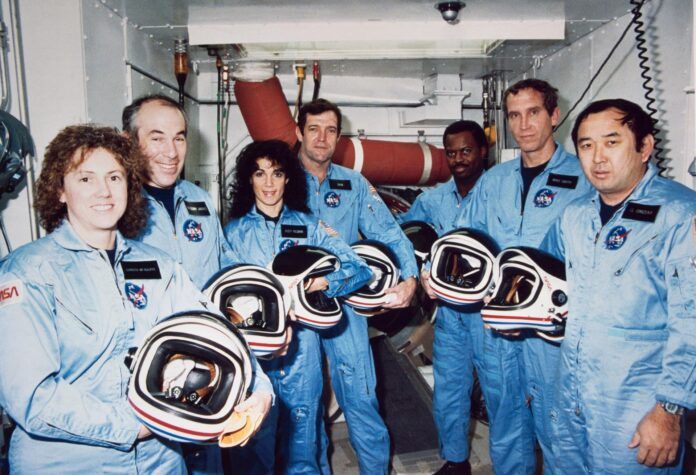NASA has confirmed that an object discovered underwater off of the east coast of Florida is an artifact from the space shuttle Challenger. According to the agency, the artifact was located by a film crew on a dive looking for the wreckage of a World War II-era aircraft. NASA stated that it is still considering what it will do regarding the object, which is reportedly a 20-foot segment of the spacecraft.
“While it has been nearly 37 years since seven daring and brave explorers lost their lives aboard Challenger, this tragedy will forever be seared in the collective memory of our country,” said NASA Administrator Bill Nelson. “For millions around the globe, myself included, Jan. 28, 1986, still feels like yesterday. This discovery gives us an opportunity to pause once again, to uplift the legacies of the seven pioneers we lost, and to reflect on how this tragedy changed us.”
The space shuttle Challenger broke apart 73 seconds after liftoff from Florida’s Kennedy Space Center on Jan. 28, 1986, killing all onboard. The crew included commander Francis R. “Dick” Scobee, pilot Michael J. Smith, mission specialists Ronald E. McNair, Ellison S. Onizuka and Judith A. Resnik, payload specialist Gregory B. Jarvis and teacher S. Christa McAuliffe. The loss of the Challenger, which was the first fatal accident involving a U.S. spacecraft in-flight, was traced back to O-ring seal failures in the solid rocket booster segment joints due to unexpectedly low temperatures prior to the launch.




































When El Onizuka instructed at the USAF Test Pilot School, we would write his name–along with the flight test pilot faculty handles–on the schedule board for the next day, then all the IPs would wander in and let us know whether they could make that flight. Nine times out of nine, they would change the schedule time, but old El was reliable and accommodating, and he would rarely require that adjustment. He was a good guy.
There are still remnants of Columbia scattered around Texas and adjoining states. That would be a less daunting search region to find artifacts. I’m sure they’ve got a small contingent of prospectors poking around bushes and fields to locate those chunks of history.
I worked instrumentation data collection systems at Edwards for 15.5 years, I remember Onizuka coming into our shop on numerous occasions to learn more about these systems. A genuine nice guy.
Hopefully, they will ensure the piece is brought to the surface and placed somewhere. IF not every scavenger will be diving in that area. They had to secure the Titanic area from these people to preserve that wreckage.
I was on a flight of 4 over the Pacific when we got word of this tragic day. After landing in Japan and getting our debrief we all headed to the ready room to see what was being reported.
I vividly remember that flight as being one in which the Thiokol engineers warned repeatedly that the O-rings might fail and requested delay until warmer temps…but thinking mostly of their future budgetary allowances…NASA was determined to launch that teacher for marketing purposes. And McAuliffe’s family and young students all standing there in the bleachers watching first-hand….
Then, in 2000, NASA fell victim to it’s own foolhardy self-confidence again…again mostly worried about it’s next budget more than about the lives of the crew…actually deceiving the crew about the suspected damage.
Now, here we go again throwing huge money to revisit a dusty rock we’ve already visited and found worthless.
I’d rather the money be spent on resolving Earthly issues than exporting our fallacies to other worlds.
I meant my comments as applied to public money. If pvt or commercial interests wish to pursue the moon and mars on their own nickel …. I’ll cheer them on.
NASA knew their shuttle was an albino pachyderm from the get go, and that the promised ‘commercial’ utility of their design would never meet projected mission goals. Nevertheless, they continued the program to completion, then watched their space truck fail time after time during some phase of the launch or mission segments. Their customers backed out of the program after the Challenger disaster, and the sole clients NASA could muster for missions were DoD, and the International Space Station boondoggle. My heart sank when the Manned Mars Mission funding was cut, because there was a genuine opportunity to advance America’s Space Program to levels that would astound people around the world.
The accident that could’ve been avoided if NASA’s management had respected the engineer saying “don’t fly, it’s too cold, the O-ring will not seal the high pressure gases from the boosters!”
NASA management: “OH no, we cannot wait, we have to launch”.
That was the same as saying:
“OH we don’t care about anything let’s go a head and explode the rocket so everyone can see how dumb we are”!
In the end precious lives were lost and the program was halted for two years. So much for “we can’t wait”.
Unbelievable. It shocks me every time I hear about this “accident”.
It happens everywhere. Management cannot be wrong, because, well, they are management. I doubt humans will ever learn. I also recall that President Reagan was expecting the launch, and none of the managers wanted to disappoint him. But, they did!
I lost my job with the FAA because I refused to sign off on returning a system to service. They destroyed my life the best they could… my wife still tells me I did the right thing. My career ended with that choice.
That was a perfect, somber, respectful, and comprehensive statement by NASA’s Bill Nelson. Thank you.
My father was called out of retirement to investigate this accident for NASA. I remember it well.